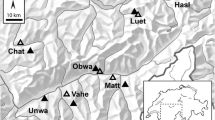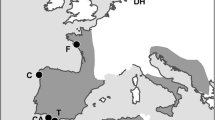Abstract
Dispersal ability is an important fitness component in most plant species. Therefore, some phenotypic traits can be selected due to their effect on dispersal. In this study I determine the potential for dispersal-mediated selection on plant height in an autochorous plant, Erysimum mediohispanicum (Brassicaceae). Selection was quantified by selection gradients, structural equation modeling and generalized additive models. I detected significant dispersal-mediated linear selection gradient on plant height, taller plants dispersing seeds farther. Nevertheless, the generalized additive models suggest that the selection on stalk height was non linear. Indeed, it detected a threshold in the effect of stalk height on dispersal ability; plants shorter than that threshold had an extremely short dispersal, whereas plants taller than that threshold dispersed the seeds very far. Furthermore, the structural equation modeling showed that stalk height indirectly affected dispersal distance through its significant effect on one reproduction-related fitness component, taller plants having greater fecundity. Selection on E. mediohispanicum stalk height occurs through two simultaneous paths, one via producing many seeds and the other through increasing probability of dispersing them far away.
Similar content being viewed by others
References
Alcántara J and Rey P (2003). Conflicting selection pressures on seed size: evolutionary ecology of fruit size in a bird-dispersed tree. Olea europaea. J Evol Biol 16: 1168–1180
Banks DL, Olszewski RT and Maxion RA (2003). Comparing methods for multivariate nonparametric regression. Commun Stat Simul Comput 32: 541–571
Bullock JM and Clarke RT (2000). Long distance seed dispersal by wind: measuring and modelling the tail of the curve. Oecologia 124: 506–521
Cheptou PO, Lepart J and Escarré J (2001). Differenticial outcrossing rates in dispersing and non-dispersing achenes in the heterocarpic plant Crepis sancta (Asteraceae). Evol Ecol 15: 1–13
Clark JS, Beckage B, Camill P, Cleveland B, Hillerislambers J, Lichter J, Mclachlan J, Mohan J and Wyckoff P (1999). Interpreting recruitment limitation in forests. Amer J Bot 86: 1–16
Donohue K (1997). Seed dispersal in Cakile edentula var. lacustris: decoupling the fitness effects of density and distance from the home site. Oecologia 110: 520–527
Donohue K (1998). Maternal determinants of seed dispersal in Cakile edentula: fruit, plant and site traits. Ecol 79: 2771–2788
Donohue K (1999). Seed dispersal as a maternally influenced character: mechanistic basis of maternal effects and selection on maternal characters in an annual plant. Amer Naturalist 154: 674–689
Donohue K, Polisetty CR and Wender NJ (2005). Genetic basis and consequences of niche construction: plasticity-induced genetic constraints on the evolution of seed dispersal in Arabidopsis thaliana. Amer Naturalist 165: 537–550
Falconer DS and Mackay TFC (1995). Introduction to quantitative genetics, 4th ed. Longman Scientific and Technical, New York
Forget PM, Lambert JR, Hulme PE, Vander Wall SB (2005) Seed fate: predation, dispersal and seedling establishment. CABI.
Ganeshaiah KN and Uma Shaanker R (1991). Seed size optimization in a wind dispersed tree Butea monosperma: a trade off between seedling establishment and pod dispersal efficiency. Oikos 60: 3–6
Gómez JM (2003). Herbivory reduces the strength of pollinator-mediated selection in the Mediterranean herb Erysimum mediohispanicum: Consequences for plant specialization. Amer Naturalist 162: 242–256
Gómez JM (2005a). Non-additivity effect of herbivores and pollinators on Erysimum mediohispanicum (Cruciferae) fitness. Oecologia 143: 412–418
Gómez JM (2005b). Ungulate effect on the performance, abundance and spatial structure of two montane herbs: A 7-yr experimental study. Ecol Monogr 75: 231–258
Gómez JM, Perfectti F and Camacho JPM (2006). Natural selection on Erysimum mediohispanicum flower shape: Insights into the evolution of zygomorphy. Amer Naturalist 168: 531–545
Greene DF and Johnson EA (1989). A model of wind dispersal of winged or plumed seeds. Ecology 70: 339–347
Greenwood-Lee JM and Taylor PD (2001). The evolution of dispersal in spatially varying environments. Evol Ecol Res 3: 649–665
Hamilton WD and May RM (1977). Dispersal in stable habitats. Nature 269: 578–81
Hastie TJ and Tibshirani RJ (1986). Generalized additive models. Stat Sci 1: 297–318
Hastie TJ and Tibshirani RJ (1990). Generalized additive models. Chapman and Hall, New York
Hedge SG, Uma Shaanker R and Ganeshaiah KN (1991). Evolution of seed size in the bird-dispersed tree Santalum album L.: a trade-off between seedling establishment and dispersal efficiency. Evol Trends Pl 5: 131–135
Howe HF and Miriti MN (2004). When seed dispersal matters. BioScience 54: 651–660
Howe HF and Smallwood J (1982). Ecology of seed dispersal. Annual Rev Ecol Syst 13: 201–228
Jordano P (1995). Frugivory-mediated selection on fruit and seed size: birds and St. Lucie's Cherry, Prunus mahaleb. Ecology 76: 2627–2639
Lande R and Arnold SJ (1983). The measurement of selection on correlated characters. Evol 37: 1210–1226
Levey DJ, Galetti M (2002) Seed dispersal and frugivory: ecology, evolution and conservation. CABI.
Levin SA, Muller-Landau HC, Nathan R and Chave J (2003). The ecology and evolution of seed dispersal: a theoretical perspective. Ann Rev Ecol Evol Syst 34: 575–604
McEvoy PB and Cox CS (1987). Wind dispersal distances in dimorphic achenes of ragwort, Senecio jacobaea. Ecology 68: 2006–2015
Meyer SE and Carlson SL (2001). Achene mass variation in Ericameria nauseosus (Asteraceae) in relation to dispersal ability and seedling fitness. Funct Ecol 15: 274–281
Moles AT, Ackerly DA, Webb CO, Tweddle JC, Dickie JB, Pitman AJ and Westoby M (2005). Factors that shape seed mass evolution. Proc Natl Acad Sci USA 102: 10540–10544
Morris DW, Lundberg P and Ripa J (2001). Hamilton's rule confronts ideal free habitat selection. Proc Roy Soc Lond Ser B 268: 921–924
Morse DH and Schmitt J (1985). Propagule size, dispersal ability and seedling performance in Asclepias syriaca. Oecologia 67: 372–379
Narbona E, Arista M and Ortiz PL (2005). Explosive seed dispersal in two perennial Mediterranean Euphorbia species (Euphorbiaceae). Amer J Bot 92: 510–516
Nathan R, Safriel UN, Noy-Meir I and Schiller G (2000). Spatiotemporal variation in seed dispersal and recruitment near and far from Pinus halepensis trees. Ecology 81: 2156–2169
Nathan R, Safriel UN and Noy-Meir I (2001). Field validation and sensitivity analysis of a mechanistic model for tree seed dispersal by wind. Ecology 82: 374–388
Nathan R, Perry G, Cronin JT, Strand AE and Cain ML (2003). Methods for estimating long-distance dispersal. Oikos 103: 261–273
Olivieri I, Michalakis Y and Gouyon PH (1995). Metapopulation genetics and the evolution of dispersal. Amer Naturalist 146: 202–228
Picó X, Ouborg NJ and van Groenendael J (2004). Influence of selfing and maternal effects on life-cycle traits and dispersal ability in the herb Hypochaeris radicata (Asteraceae). Bot J Linn Soc 146: 163–170
Pugesek BH (2003). Modeling means in latent variable models of natural selection. In: Pugesek, BH, Tomer, A and von Eye, A (eds) Structural equation modeling, applications in ecological and evolutionary biology, pp 297–311. Cambridge University Press, Cambridge
Rawling JO, Pantula SG and Dickey DA (1998). Applied regression analysis, a research tool. Springer, Germany
Schluter D and Nychka D (1994). Exploring fitness surfaces. Amer Naturalist 143: 597–616
Shipley B (2000). Cause and correlation in biology. Cambridge University Press, Cambridge
Sheldon JC and Burrows FM (1973). The dispersal effectiveness of the achene-pappus units of selected Compositae in steady winds with convection. New Phytol 72: 665–675
Skarpaas O, Stabbetorp OE, Ronning I and Svennungsen TO (2004). How far can a hawk's beard fly? Measuring and modelling the dispersal of Crepis praemorsa. J Ecol 92: 747–757
Soons MB and Heil GW (2002). Reduced colonisation capacity in fragmented populations of wind-dispersed grassland forbs. J Ecol 90: 1033–1043
Soons MB, Heil GW, Nathan R and Katul GG (2004). Determinants of long-distance seed dispersal by wind in grasslands. Ecology 85: 3056–3068
StatSoft (2004) STATISTICA for Windows (program manual). StatSoft, Tulsa
The R Development Core Team (2005) R 2.0.0: A Language and Environment. The Foundation for statistical Computing, Vienna. http://www.r-project.org
Thiede DA and Augspurger CK (1996). Intraspecific variation in seed dispersion of Lepidium campestre (Brassicaceae). Amer J Bot 83: 856–866
Thode HC (2002). Testing for normality. Marcel Dekker, New York
Venable DL and Levin DA (1985). Ecology of achene dimorphism in Heterotheca latifolia. I. Achene structure, germination and dispersal. J Ecol 73: 133–145
Wender NJ, Polisetty CR and Donohue K (2005). Density-dependent processes influencing the evolutionary dynamics of dispersal: a functional analysis of seed dispersal in Arabidopsis thaliana (Brassicaceae). Amer J Bot 92: 960–971
Wenny DG (2000). Seed dispersal, seed predation and seedling recruitment of a neotropical montane tree. Ecol Monogr 70: 331–351
Wenny DG (2001). Advantage of seed dispersal: a re-evaluation of direct dispersal. Evol Ecol Res 3: 51–74
Author information
Authors and Affiliations
Corresponding author
Rights and permissions
About this article
Cite this article
Gómez, J. Dispersal-mediated selection on plant height in an autochorously dispersed herb. Plant Syst. Evol. 268, 119–130 (2007). https://doi.org/10.1007/s00606-007-0568-4
Received:
Accepted:
Published:
Issue Date:
DOI: https://doi.org/10.1007/s00606-007-0568-4




